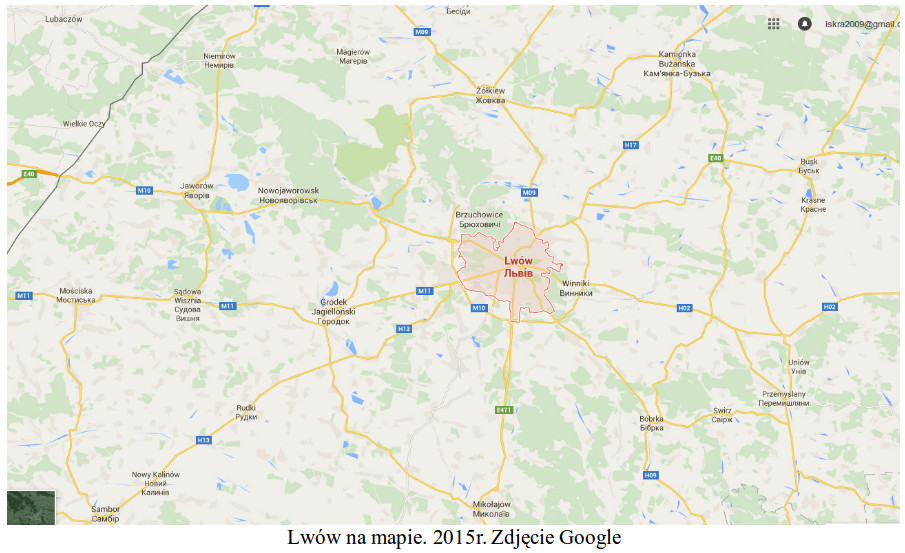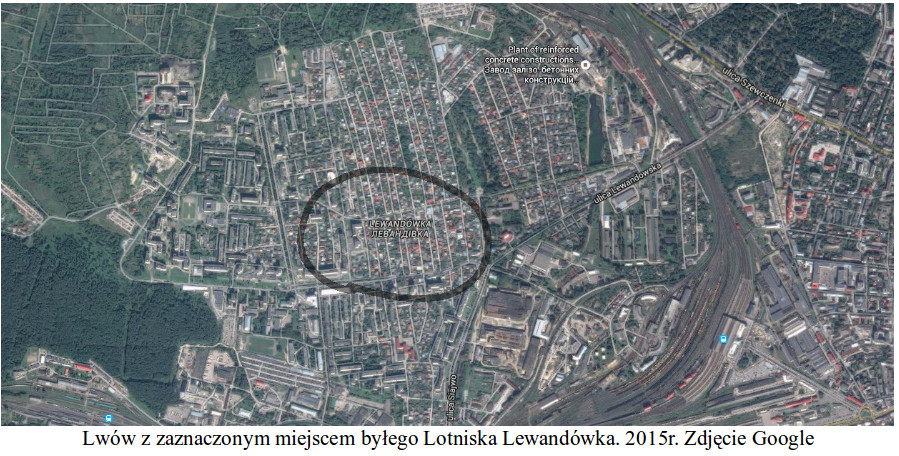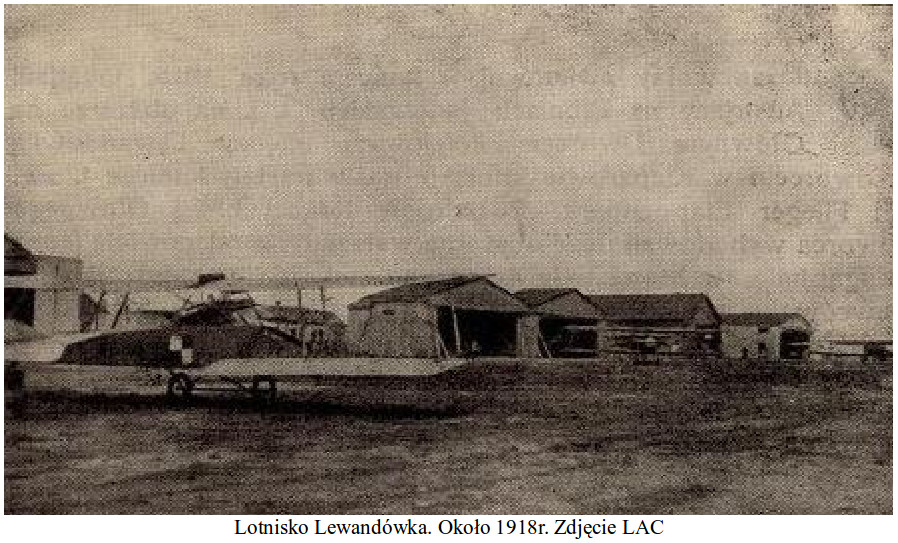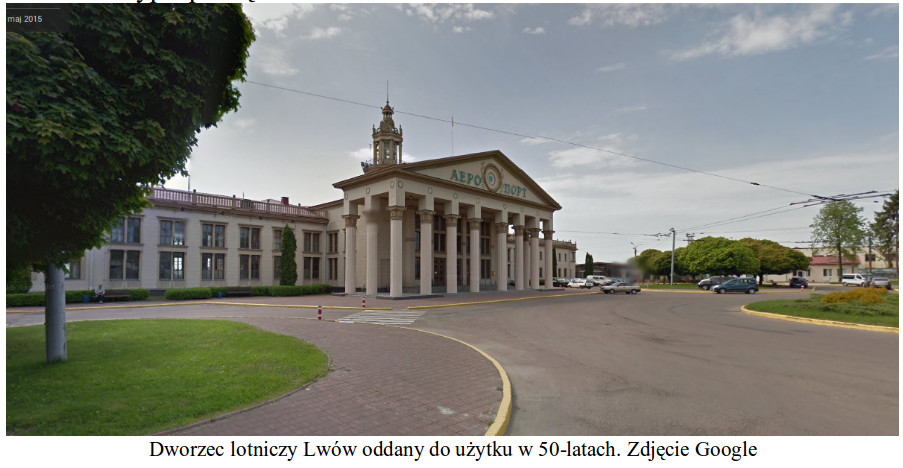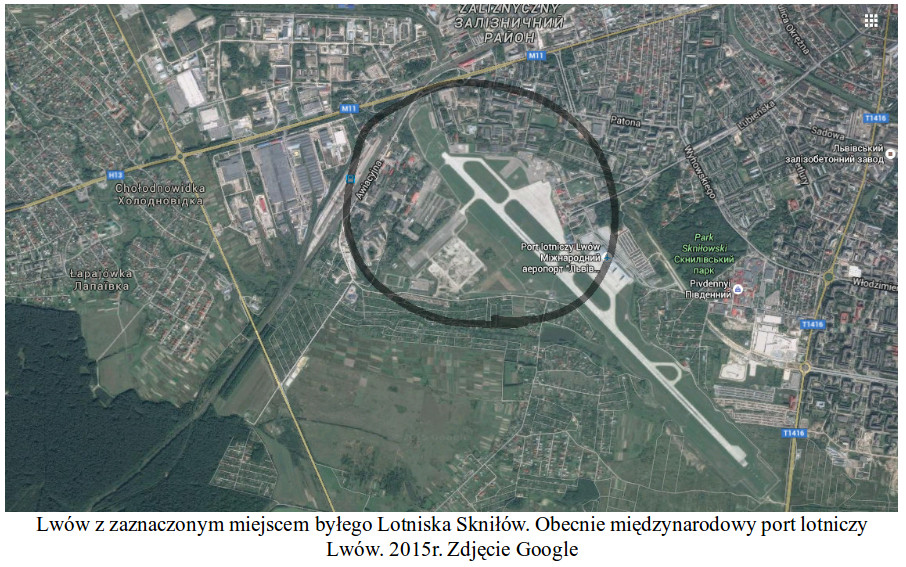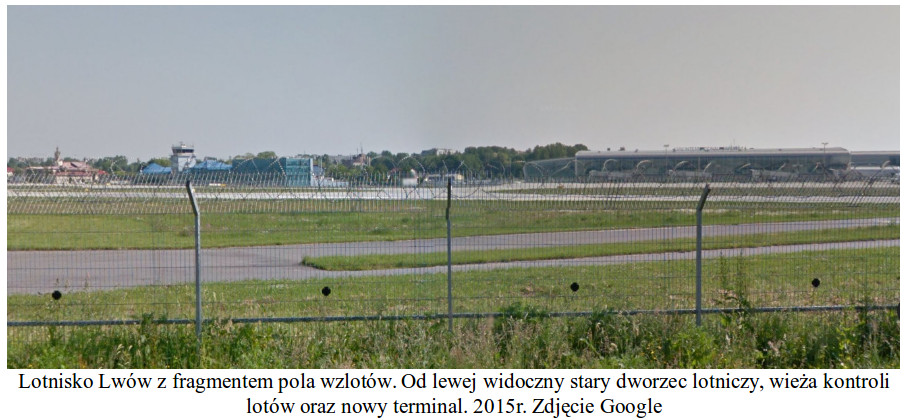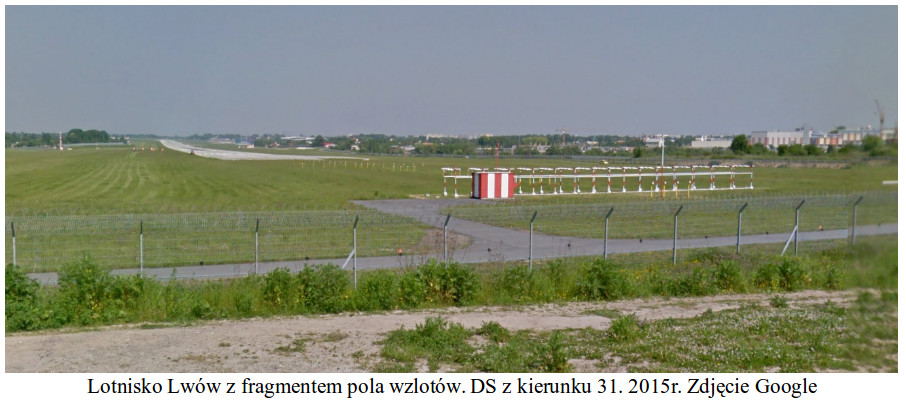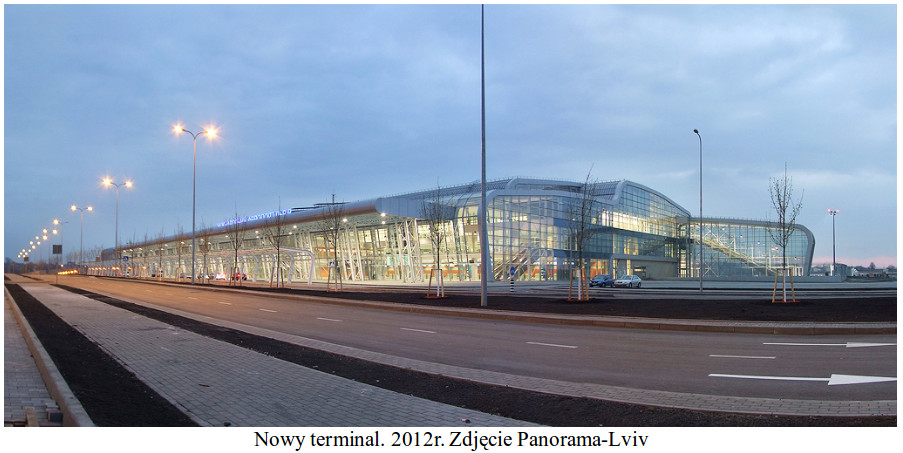Kraków 26.10.2015r.
Lotniska Lwowa
Lewandówka i Skniłów
Historia
Historia Lwowa
Badania archeologiczne dowodzą, że osada istniała tutaj już w V wieku. Władał tutaj Daniel Halicki, król Rusi, który gród nazwał Lwów na cześć swojego syna Lwa. Koronacja Daniela Halickiego nastąpiła w 1340r. Lwów stał się stolicą królestwa Ruskiego. W XIV wieku dynastia Halicka wymarła i panowanie nad tymi terenami przejmuje Polski Król Kazimierz III Wielki. W 1356r., Lwów uzyskuje prawa miejskie oparte na prawie zachodnim. Lwów przeżywa złoty okres rozwoju. W 1412r., Lwów staje się siedzibą metropolity łacińskiego i arcybiskupstwem. Ale Miasto jest wielokulturowe i wieloreligijne: Katolicy, prawosławni i religia mojżeszowa. Bywali tutaj często monarchowie i książęta Polscy i Litewscy. Rozwijał się handel i rzemiosło. W 1444r., Miasto otrzymuje prawo składu. Zbudowane zostają dwa zamki; dolny i górny. Powstają pierwsze szkoły przykościelne. Jednak Miasta nie omijają wielkie pożary: 1479r., 1494r., 1511r., 1527r. Co jakiś czas Miasto było napadane przez turków, tatarów, kozaków (Bohdan Chmielnicki) i szwedów (1704r.). wielokrotnie Miastu udawało się odnieść zwycięstwo. Tutaj w dniu 1.04.1656r., Król Polski Jan II Kazimierz przed cudownym obrazem Matki Boskiej Łaskawej złożył śluby lwowskie. Od XVI wieku w Mieście funkcjonuje drukarnia. W 1661r., otwarto kolegium Jezuickie. W Mieście są klasztory jezuitów i bernardynów. W XVII wieku Lwów liczył około 30 000 mieszkańców. Mniej niż w Gdańsku, ale więcej niż w Krakowie. Lwów był na szlaku kupieckim od Bałtyku do Morza Czarnego, co sprzyjało rozwojowi Miasta.
Lwów pozostaje Polski do pierwszego rozbioru 1772r., po którym staje się stolicą prowincji Galicja i Lodomerii. Wojska austriackie zajęły Miasto w dniu 19.09.1772r. Nastał okres germanizacji. Językiem urzędowym stał się niemiecki. Akademie przekształcono w germańską. Zaborca prowadził sekularyzację Miasta. Zlikwidowano 18 kościołów rzymskokatolickich, 3 kościołów ormiańsko-katolickich i 7 greckokatolickich. Nastąpiła kasata zakonów. Budowle przeznaczono na cele świeckie lub rozebrano pozyskując materiał budowlany. Klasztor Ojców Bonifratrów zamieniono na szpital garnizonowy. Zmieniono system administracyjny, sądowniczy i podatkowy.
Patriotyzm jednak nie ustał. Lwowska młodzież gremialnie brała udział w Polskich powstaniach. W 1776r., zostaje założony Polski teatr. Początkowo grano sztuki używając języka niemieckiego, ale z czasem większość przedstawień teatralnych była wystawiana w języku Polskim. Wystawiano sztuki Aleksandra Fredry i Józefa Korzeniowskiego. To we Lwowie wystawiono „Moralność Pani Dulskiej”. Na ulicach mówiono po Polsku. Z wydawanych gazet tylko jedna była w języku niemieckim. Niestety, przy okazji powstawały loże wolnomularstwa.
Od 1777r., zaczyna się przebudowa Miasta. Na początku rozebrano stare mury obronne. W 1784r., kolegium Jezuickie przekształcono w Uniwersytet. W 1817r., złażono Ossolineum. W 1844r., ukończono budowę nowego gmachu uniwersytetu. W 1844r., otwarto Akademię Techniczną. W 1873r., uruchomiono gazowe oświetlenie ulic. W 1868r., otwarto linie kolejową Lwów-Kraków, a także do Czerniowic i Brodów. Lwów staje się ważnym węzłem kolejowym. W 1880r., ruszyła pierwsza linia tramwaju konnego, a od 1894r., tramwaj elektryczny, pierwszy w cesarstwie Austro-Węgier. W 1883r., uruchomiono centralę telefoniczną. W 1893r., powstało konne pogotowie ratunkowe. W 1900r., otwarto Wielki Teatr i Operę. W 1901r., uruchomiono elektrownię miejską. W 1904r., zbudowano nowy dworzec kolejowy.
W drugiej połowie XIX wieku Galicja uzyskuje znaczną autonomie. Uzyskuje uprawnienia samorządowe. Następuje polonizacja administracji, szkolnictwa i kultury. Powstają liczne organizacje i stowarzyszenia typowo Polskie. Miasto było jednym z najbardziej „zielonych” w Europie, bo miało wiele parków i ogrodów. W parkach ustawiano wiele rzeźb przedstawiających znamienitych synów Nardu Polskiego. Miasto rozwijało się dzięki przemysłowi naftowemu. Zakładano muzea i szkoły muzyczne. Wiele wybitnych dział sztuki malarskiej powstało we Lwowie, między innymi Panorama Racławicka. Organizowane są wystawy przemysłowe i rolnicze. W 1869r., lwowianie usypali Kopiec Unii Lubelskiej w jej 300-rocznicę. W 1871r., dokonano nowego podziału administracyjnego. Nadano nowe nazwy ulicom i placom. Wysoka kultura, teatry, szkolnictwo, rozwój technologiczny, to wszystko sprawiło, że Lwów był nazywany Małym Wiedniem.
W dniu 1.08.1914r., wybuchła wielka wojna światowa. Wojsko Austro-Węgier wycofało się w nocy z 2/3.09.1914r. Moskale wkroczyli do Miasta w nocy z 3 / 4.09.1914r., i zajęli je na kilka miesięcy. Rozpoczął się terror, jakiego Lwów jeszcze nie doświadczył. W dniu 20.06.1915r., wojenny front doprowadził do ponownego zajęcia Lwowa przez wojska Austriackie. W tym okresie Ukraińcy ponownie szukają swojego samostanowienia. W dniu 9.02.1918r., zawierają pakt z cesarstwem niemieckim, a 3.03.1918r., z Austro-Węgrami, które uznały częściową autonomię nowej Ukrainy. Jednak na tym nie koniec. W dniu 1.11.1918r., Ukraińcy proklamują Zachodnio-Ukraińską Republikę Ludową i wyganiają władze Austro-Węgier. W 1918r., powołują własną radę narodową, wywieszają własne flagi, mianują własnego prezydenta. Polacy nie przyjęli takiego obrotu sprawy i w listopadzie 1918r., wybuchła wojna Polsko-ukraińska. Do walki przeciw strzelcom siczowym staje patriotyczna młodzież Polska „Orlęta Lwowskie”. Z odsieczą przybyło Wojsko Polskie. Ukraińcy zostali wygnani z Miasta, ale jeszcze długo je oblegali. Układy podpisano dopiero w 1921r. W dniu 17.08.1920r., miasto skutecznie obroniło się przed moskalami (bolszewikami), którzy nie powtórzyli szturmu, bo ruszyli na Warszawę. W dniu 22.11.1920r., Marszałek Józef Piłsudski odznaczył Miasto Orderem Virtuti Militari.
W II Rzeczypospolitej Lwów to trzecie co wielkości miasto po Warszawie i Łodzi. Jest siedzibą trzech wielkich religii chrześcijańskich: rzymskokatolicka, greckokatolicka, ormiańskokatolicka. W 1929r., we Lwowie funkcjonują 4 wyższe uczelnie, 31 gimnazjów (2 z językiem ukraińskim, 2 żydowskie, 1 niemieckie), 45 szkół podstawowych miejskich i 23 szkół prywatnych. W 1930r., uruchomiono Polskie Radio Lwów, a w 1932r., ruszyła telewizja. Budowano nowe szkoły, szpitale i kościoły. Budowano nowe domy i odnawiano stare. Przebudowano 1/3 ulic. Zaczęto na wzór Paryża budować obwodnice centrum. Powstawały baseny pływackie, w tym kryte. Rozbudowywano sieć elektryczną, gazową, kanalizacyjną i wodociągową.
W dniu 1.09.1939r., germańcy napadli na Rzeczypospolitą, a w dniu 17.09.1939r., pomogli im moskale. Kacapy przekroczyły rzekę Zabucz i 22.09.1939r., zajęli Lwów. Podpisano akt kapitulacji, który miał zagwarantować wymarsz żołnierzy Wojska Polskiego z Miasta w kierunku Rumunii. Kacapy złamali umowę. Wszystkich żołnierzy wywieźli i wymordowali w głębi państwa moskiewskiego. Policjantów wymordowali przy drodze wylotowej z Miasta na Winniki, przy pomocy karabinów maszynowych.
Powołano republikę Zachodniej Ukrainy podległą kremlowi, a następnie włączono w skład CCCP. Rozpoczął się kolejny terror na ludności Polskiej. Z byle powodu mordowano ludzi bez opamiętania. W wiezieniu przy ul Łąckiego wymordowano wszystkich więźniów. NKWD w dniach 9/10.12.1939r., aresztowało około 2 000 zarejestrowanych i spisanych pozostałych Polskich oficerów Wojska Polskiego i policjantów, a następnie zesłano i wymordowano w głębi państwa moskiewskiego. Potem zabrano się za deportację ich rodzin na Syberię i do Kazachstanu. Moskale wprowadzili własną walutę, kalendarz państwa moskiewskiego i czas moskiewski. Pozostali Polacy stali się obywatelami państwa moskiewskiego ze wszystkimi tego konsekwencjami, np. poborem do wojska. To we Lwowie zrodziła się kolejna zaraz komunistyczna w postaci komuchów z Polskim rodowodem: Wanda Wasilewska, Władysław Broniewski, Aleksander Wat. Wydają oni polsko-języczne pismo „czerwony sztandar”. Okupacja Lwowa przez moskali trwała od 23.09.1939r., do 29.06.1941r. Wycofujący się moskale w więzieniach wymordowali 7 000 więźniów politycznych Polaków i Ukraińców.
Kiedy germańcy i moskale wzięli się za głowy, Lwów został zajęty przez zarazę germańską i nacjonalistów ukraińskich. Sytuacja lwowian stała się jeszcze gorsza. Rozpoczął się pogrom żydów lwowskich, a terror wobec ludności Polskiej nie ustał. Masowe aresztowania i publiczne egzekucje były niezwykle częste. Rozstrzeliwania i szubienice stały się codziennością. W więzieniach i obozach ludność umierała z głodu i chorób. W nocy 3 / 4.07.1941r., wymordowano profesorów wyższych uczelni i ich rodzin. 25.07.1941r., zamordowano Kazimierza Bartla (były premier Rzeczypospolitej. Nie mylić z Ryszardem Bartlem, Polskim konstruktorem lotniczym). Spalono wszystkie synagogi. Utworzono getto.
Oprócz Polaków i żydów w germańskich obozach we Lwowie i okolicach ginęli żołnierze francuscy i włoscy. Ucierpiała kultura. Skradziono i wywieziono do rajchu liczne dzieła sztuki. Okupacja germańska trwała od 29.06.1941r., do 23.07.1944r. W dniach 23/27.07.1944r. Armia Krajowa przeprowadziła nieudaną akcję Burza.
W dniu 27.07.1944r., kacapy weszły do miasta i nastała kolejna okupacja moskiewska. W wyniku działań wojennych zabudowa Lwowa nie ucierpiała wiele. Represje na ludności nie ustały. Zmienił się tylko ich gatunek. Wymordowano kapłanów Kościoła greckokatolickiego. W 1945r., rozpoczęły się wysiedlenia pozostałej ludności Polskiej na „ziemie odzyskane”, które trwały do 15.06.1946r. W dniu 31.03.1946r., zlikwidowano Kościół rzymskokatolicki, a arcybiskup Eugeniusz Baziak opuścił Lwów w dniu 26.04.1946r.
Lwów stał się prowincjonalnym zaniedbanym miastem państwa moskiewskiego, o którego świetności przypominały tylko piękne gmachy i pomniki. Kościoły zamieniono w teatry, kina, sale sportowe lub magazyny.
Ukraina uzyskała niepodległość 3.04.1990r., choć już flaga na ratuszu wisiała od jesieni 1989r. W dniach 25/27.06.2001r., Jan Paweł II byłe we Lwowie z Pielgrzymką Apostolską. Papież Mszę św odprawił w dniu 27.06.2001r., na hipodromie.
Lwów obecnie
Geograficznie Lwów leży na Wyżynie Podolskiej w rozległej kotlinie w dorzeczu Dniestru. Do Morza Bałtyckiego i Morza Czarnego jest po około 600 km, czyli w połowie drogi. Współrzędne geograficzne 24 stopnie długości geograficznej wschodniej i 49 stopni szerokości geograficznej północnej. Średnia wysokość wynosi 312 m npm. Samo Miasto nie ma większej rzeki. Obecnie, na mapie politycznej znajduje się w zachodniej Ukrainie, w odległości około 100 km od granicy Rzeczypospolitej. Ma powierzchnię 182 km2. Ma 757 000 mieszkańców, co daje gęstość około 4 300 osób/km2. Administracyjnie składa się z 6 dzielnic. Miasto ma słabą sieć komunikacji zbiorowej. Autobusy i tramwaje kursują nieregularnie.
Lotnisko Lewandówka
Zainteresowanie lwowian aeronautyką datuje się bardzo wcześnie. Już w 1884r., założono Towarzystwo Aeronautyczne, które wydało periodyk Aeronauta (Astronauta). Jedno z pierwszych tego typu na świecie. Towarzystwo jednak nie przetrwało długo. Lwów był prężnym ośrodkiem akademickim. Zagadnieniami lotu mechanicznego zajmował się wydział budowy maszyn Szkoły Politechnicznej, czyli późniejszej Politechniki Lwowskiej. W 1909r., ludzie zainteresowani lotnictwem utworzyli spółkę o nazwie Awiata. Nie mylić z Warszawskim Towarzystwem Lotniczym Awiata w Warszawie. Zadaniem Lwowskiej Awiaty była popularyzacja lotnictwa poprzez odczyty, wystawy i pokazy. Prezentowano latawce i balony. Do Lwowa zapraszano lotników francuskich. To we Lwowie udane pokazy samolotowe demonstrował pierwszy Polski pilot Scipio del Campo, który licencję pilota zdobył we Francji. Do tych pokazów wykorzystywano tor wyścigów konnych koło Persenówki.
Pierwsze samoloty we Lwowie zaczęto budować w 1910r., a możliwe, że rok wcześniej. Konstrukcje te powstawały w stodołach, które stawały się hangarami. Do wielkiej wojny światowej w Lwowie powstało kilka konstrukcji samolotów, których próby wypadły ze zmiennym szczęściem. Jako pola wzlotów wykorzystywano różne miejsca, a wśród nich Pola Kulparkowskie i Błonia Janowskie.
Do 1914r., Lwów nie doczekał się własnego lotniska. Wielka wojna światowa przyniosła zmiany. Lotnisko zakładają Austriacy pomiędzy czerwcem 1915r., a końcem 1917r., na tak zwanej Lewandówce będącej częścią Janowskich Błoń, na zachód od centrum Miasta. Tutaj w pobliżu była kolejowa stacja towarowa, a nieopodal główny dworzec kolejowy Lwowa. Błonia Janowskie były wykorzystywane przez żołnierzy pobliskich koszar jako plac ćwiczeń. Trwała wojna, więc lotnisko miało stosunkowo ubogie zaplecze. Postawiono cztery drewniane hangary. Każdy z nich mieścił jeden samolot. W hangarach obsługiwano i remontowano samoloty. Była także stacja paliw, stacja meteorologiczna oraz barak komendantury lotniska.
W 1918r., sytuacja we Lwowie rozwijała się niekorzystnie dla ludności Polskiej, o czym napisałem powyżej. W dniu 1.11.1918r., wybuchła wojna Polsko-ukraińska. W dniu 2.11.1918r., żołnierze Polskiej Organizacji Wojskowej udali się na lotnisko, żądając od austriackiego komendanta oddania lotniska. Było to zuchwałe, bo było to zaledwie trzech nieuzbrojonych Polskich żołnierzy. Niespodziewanie w sukurs przybyli studenci szkół lwowskich. Komendant dojść szybko ustąpił, bo władze austriackie już opuściły Lwów. Otrzymał nawet od Polaków zaświadczenie, że został zmuszony do oddania lotniska. Austriacy zdążyli jednak uszkodzić wszystkie samoloty, które były w hangarach i na błoniach. W ciągu kilku godzin zorganizowano pierwszą Polską Eskadrę Bojową, której dowódcą został kapitan Stefan Bastyr. Mechanicy i piloci szybko wzięli się do pracy. W ciągu trzech dni udało się naprawić dwa samoloty Hansa-Brandenburg C.I. Na lotnisku były także samoloty Oeffag C.II. Na wszystkich samolotach zamalowano czarne krzyże, a końcówki płatów pomalowano na biało-czerwono. Biało-czerwona szachownica pojawiła się kilka dni później. W dniu 5.11.1918r., samolot pilotowany przez kpt. pilota Stefana Bastyra z obserwatorem por. Januszem de Beauriain wykonał pierwszy lot bojowy Polskiego samolotu. Przeprowadzano loty obserwacyjne i atakowano oddziały ukraińskie. Przybywało pilotów, obserwatorów i mechaników, ale brakowało samolotów. Mieli tylko trzy sprawne maszyny. Dlatego zastosowano fortel w postaci wielokrotnych przelotów trójki samolotów, co sprawiało warzenie o liczności i potędze Polskiego Lotnictwa. Do maja 1919r., jednostka wykonała 69 lotów bojowych. Zrzucono 250 bomb i prowadzono ostrzał z broni maszynowej.
Lwowska jednostka wykonywała także loty kurierskie, głównie do Krakowa. W dniu 8.11.1918r., wykonano lot w którym po raz pierwszy przewieziono pasażera na pokładzie Polskiego samolotu. Tym pasażerem był profesor Stanisław Stroński (1882r.-1955r., polityk, publicysta, filolog). Celem podróży był Kraków. Jednak samolot nie doleciał do celu podróży, bo został ostrzelany i przymusowo wylądował koło Łańcuta.
Jeszcze nie wygasła wojna Polsko-Ukraińska, a już rozgorzała wojna Polsko-bolszewicka (1919r.-1921r.), w której w pierwszym okresie Lotnisko Lewandówka odegrało ważną rolę. W walkach brało już udział regularne Wojsko Polskie. Polskie Lotnictwo było już dobrze zorganizowane. Z pomocą Polskim lotnikom przybyli Amerykanie (z USA) i Włosi.
Z początkiem 20-lat Lotnisko Lewandówka dysponowała skromnym zapleczem. Miało kilka niewielkich drewnianych hangarów i kilka baraków które pełniły rolę warsztatów i magazynów. Były one wyeksploatowane i częściowo zniszczone w wyniku działań wojennych. Pole wzlotów miało wymiary około 500 m x 500 m, a były to już w tamtym czasie niewielkie wymiary. Jego nawierzchnia była w złym stanie i w wielu miejscach była grząska i błotnista. Nie posiadała systemu melioracyjnego. Lotnisko nie miało instalacji wodnej, kanalizacyjnej, gazowej lub elektrycznej. Był skład paliw i posterunek meteorologiczny. Warsztaty, które zajmowały się remontami samolotów ujęto w ramy prawne i nadano im nazwę Lwowskie Warsztaty Lotnicze. Było to istotne, gdyż w ten sposób warsztat uzyskał stabilne finansowanie. Remontowano tutaj zarówno płatowce jak i silniki. Nieco później warsztaty produkowały w niewielkiej ilości udoskonalone samoloty Hansa-Brandenburg.
W 1921r., organizacja Wojska Polskiego przeszła reorganizacje na stan pokojowy. Wszystko co dotyczyło Polskiego Lotnictwa podlegało Departamentowi IV. Żeglugi Powietrznej Ministerstwa Spraw Wojskowych (1921r.-1926r.). W departamencie, w 1923r., utworzono Referat Budowlany. Jego szefowie otrzymali zadanie uporządkowania sprawy lotnisk na terenie Rzeczypospolitej. Podjęto wówczas decyzję, że należy utrzymać istniejące lotniska, zwracając uwagę na ich standaryzację i równomierny rozwój. Jednak Lotnisko Lewandówka nie nadawało się do rozbudowy. Zapadły decyzje o budowie nowego lotniska dla miasta Lwowa, utrzymując stare lotnisko do czasu uruchomienia nowego. Dlatego to na planach miasta Lwowa już w 1923r., zaznaczano Lotnisko Lewandówka jako stare lotnisko.
W 1923r., reaktywowano uczelniany związek awiatyczny, który zajął się głównie szybowcami i szkoleniem młodych pilotów. Dobre zaplecze dydaktyczne spowodowało, że lwowskie szybownictwo i ośrodek w Bezmiechowej stał się kuźnią kadr lotniczych. Oficjalnie Szkoła Szybowcowa w Bezmiechowej powstała w 1932r. W lutym 1928r., Związek Awiatyczny na swojej bazie powołał do istnienia Aeroklub Lwowski. Także w 1928r., na Wydziale Mechanicznym Politechniki utworzono Sekcję Lotniczą. W 1929r., sekcja otrzymała nowe laboratorium aerodynamiczne. W 1930r., powstały Warsztaty Szybowcowe, które zbudowały około 190 szybowców. W 1937r., Warsztaty Szybowcowe zostały przejęte przez Lwowskie Warsztaty Lotnicze i zbudowano kolejne 160 szybowców. W 1932r., we Lwowie zorganizowano Instytut Techniki Szybownictwa.
Lotnisko Lewandówka stało się jednym z pierwszych lotnisk komunikacyjnych w II Rzeczypospolitej, a to za sprawą Polskiej Linii Lotniczej towarzystwa „Aerolloyd”. Towarzystwo Aerollyd spółka akcyjna powstała w połowie 1922r., jako pierwsza Polska regularna linia lotnicza. Została założona przez przemysłowców: dr. I. Wypard, dr. B. Dunin-Rzuchowski, K. Unruh. M. Mosiewicz. Wszyscy byli związani z kopalniami i przemysłem naftowym. Ich celem było dobre i szybkie skomunikowanie ich firm. Rząd Rzeczypospolitej dotował te przewozy. Z kolei Wojsko Polskie nie pobierało opłat za korzystanie z lotnisk i udostępniało informacje meteorologiczne.
Loty zainaugurowano w dniu 5.09.1922r. W tym dniu z Lotniska Mokotów wystartowały dwa samoloty. Pierwszy poleciał do Gdańska, a drugi do Lwowa. Były to samoloty Junkers F-13. Metalowy jednosilnikowy dolnopłat zabierający na pokład 4 pasażerów. Początkowo firma zakupiła w 1922r., sześć samolotów, które otrzymały znaki rejestracyjne P-PALA, P-PLAB, P-PALC, P-PALD, P-PALE, P-PALF. W 1923r., kupiono kolejne trzy maszyny; P-PALL, P-PALM, P-PALN. W 1925r., kolejne trzy maszyny P-PALL, P-PALM, P-PALN. Po reorganizacji firmy i zmianie nazwy na Aerolot, dokupiono kolejne cztery maszyny: P-PALO, P-PALP, P-PALR i P-PALS. Łącznie firma miała 16 samolotów Junkers F-13. W wypadkach utracono tylko jedną maszynę, Junkers F-13 P-PALS w 1925r.
Dodatkowo w sierpniu 1925r., firma zakupiła jeden trzysilnikowy samolot Junkers G-23 W P-PAWA. Samolot zabierał na pokład 9 pasażerów i był wyposażony w pływaki. Planowano nim wykonywać loty z Gdańska do Malmo i Kopenhagi. Pierwszy, próbny lot wykonano na trasie; Warszawa-Gdańsk-Malmo-Kopenhaga w dniu 15.08.1925r. Po próbnych lotach zrezygnowano jednak z tego planu, a samolot zwrócono wytwórni.
Baza techniczna Aerollyd była w Gdańsku. Mechanikami byli germańcy, a załogi składały się z lotników Polskich i germańskich. Kapitał firmy był mieszany, z dużym udziałem kapitału germańskiego. Jednym z warunków uzyskania koncesji była całkowita polonizacja firmy. W 1925r., firma zmieniła nazwę na Polska Linia Lotnicza Aerolot. Główną bazą stało się Lotnisko Mokotów. Mechaników wymieniono na wyszkolonych mechaników Polaków.
Linia rozwijała się i doszły kolejne połączenia: Warszawa-Kraków (18.07.1923r.), Kraków-Lwów (22.05.1925r.), Warszawa-Lwów-Bukareszt (19.02.1925r.), Warszawa-Kraków-Wiedeń (27.04.1925r., lub 21.09.1925r.), Warszawa-Łódź (1.10.1926r.), Warszawa-Kraków-Brno-Wiedeń (1926r.). Rozważano kolejne trasy do Kopenhagi i innych miast. W 1925r., linia zarejestrowała pokonanie pierwszego miliona kilometrów. W okresie 1922r.-1928r., na Lotnisko Lewandówka firma Aerolloyd-Aerolot przeprowadziła ponad 2 000 rejsów. Przewiozła ponad 5 000 pasażerów i około 200 000 kg bagażu i poczty.
Na Lotnisko Lewandówka stałe połączenie prowadziła także Polska firma lotnicza Aero. W związku z nacjonalizacją lotnictwa komercyjnego firma Aerolot i Aero w dniu 28.12.1928r., zostały włączone (z samolotami i siatką połączeń) w nowo powstałą firmę PLL LOT.
Lotnisko Lewandówka zostało zamknięte w 1929r.
Lotnisko Skniłów
W 1921r., struktura Wojska Polskiego przeszła reorganizację na stan pokojowy. Wszystko co dotyczyło Polskiego Lotnictwa podlegało Departamentowi IV. Żeglugi Powietrznej Ministerstwa Spraw Wojskowych (1921r.-1926r.). W departamencie, w 1923r., utworzono Referat Budowlany. Jego szefowie otrzymali zadanie uporządkowania sprawy lotnisk na terenie Rzeczypospolitej. Podjęto wówczas decyzję, że należy utrzymać istniejące lotniska, zwracając uwagę na ich standaryzację i równomierny rozwój. Jednak Lotnisko Lewandówka nie nadawało się do rozbudowy. Zapadły decyzje o budowie nowego lotniska dla miasta Lwowa, utrzymując stare lotnisko do czasu uruchomienia nowego. Dlatego to na planach miasta Lwowa już w 1923r., zaznaczano Lotnisko Lewandówka jako stare lotnisko i już poszukiwano nowego terenu dla lotniska we Lwowie. W 1924r., po reformie finansów Władysława Grabskiego, Sejm Rzeczypospolitej uchwalił pierwszy budżet w odrodzonej Polsce, w którym uwzględniono wydatki na wojsko w tym na budowę nowych obiektów wojskowych. Rząd podjął wówczas decyzję o budowie dwóch nowych lotnisk dla pułków lotniczych: Okęcia dla 1 Pułku Lotniczego i drugiego koło Lwowa dla 6 Pułku Lotniczego. Były to inwestycje drogie i realizowane przez kilka lat.
Dogodny teren znaleziono w odległości około 5 km od centrum Lwowa w kierunku południowo-zachodnim przy drodze do Gródka w miejscowości Skniłów. Teren ten zakupiono już w 1924r. Kupiono 200 hektarów z których 100 hektarów przeznaczono na pole wzlotów, a pozostały obszar przeznaczono pod infrastrukturę nie tylko lotniska, ale i bazy 6 Pułku Lotniczego. Na samym początku przystąpiono do drenowania i niwelowania pola wzlotów.
Przy projektowaniu Lotniska Skniłów korzystano z doświadczeń francuskich. Według nich lotnisko powinno mieć kształt koła, elipsy lub wieloboku foremnego. W zależności od przeznaczenia, jego średnica powinna wynosić: lotnisko zapasowe 800 m, lotnisko pułkowe 1 200 m, lotnisko szkolne 1 500 m. W Skniłowie pole wzlotów wyznaczono na planie koła. Wyznaczono trzy kierunki startów i lądowań, tak zwanych wybiegów. Każdy z nich o długości 600 m i szerokości 400 m. Nie wiadomo kiedy dokładnie pole wzlotów zostało uruchomione, ale można sadzić, że już w 1925r., lądowały i startowały tu samoloty. Na lotnisku zaplanowano budowę sieci wodociągowej, kanalizacyjnej i elektrycznej. Mieszkania dla kadry oficerskiej 6 Pułku Lotniczego planowano zbudować w samym Lwowie. Pierwsze budynki nowego obiektu zaczęto budować wiosną 1925r. Plany były imponujące i w większości zrealizowane do 1935r. Strefa techniczna obejmowała hangary, park techniczny (warsztaty), magazyny techniczne, skład paliw, park samochodowy, bocznicę kolejową. Jeden z hangarów był przeznaczony dla firmy przewozowej Aerolot, a od 1929r., dla PLL LOT. Strefa administracyjno-koszarowa obejmowała: budynek sztabu i komendy portu, bazę szkolną, magazyny, stołówkę z kuchnią, łaźnię, pralnię, wartownię, areszt, izbę chorych i straż ogniową. Zbudowano sieć wewnętrznych dróg. Była elektrownia, wieża ciśnień i kotłownia dla centralnego ogrzewania. Jednym słowem nowoczesny garnizon. Zakres prac przeprowadzonych w Skniłowie można porównać do tych przeprowadzonych na Okęciu, bo był to drugi tak ważny nowy obiekt lotniczy w Rzeczypospolitej.
Równocześnie z budową nowego Lotniska formowano 6 Pułk Lotniczy. Kadrę dla niego pozyskano z 1 i 3 Pułku Lotniczego. W dniu 23.05.1925r., komendant pułku pułkownik Camillo Perini wydał pierwszy rozkaz, co uznano za datę powstania jednostki. Ponieważ obiekty lotniskowe w Skniłowie były w budowie, to większość zajęć Pułk wykonywał na Lotnisko Lewnadówka. Pułk na stanie miał samoloty Potez XV. Na potrzeby Pułku zaadaptowano tartak i postawiono kilka baraków. Zbudowano sześć prowizorycznych drewnianych hangarów na ceglanych podmurówkach, których żywotność określono na 15 lat. Część żołnierzy kwaterowała w Mieście w koszarach im. Hetmana Żółkiewskiego. W lipcu 1926r., na Lotnisku Skniłów oddano do użytku warsztaty napraw płatowców, a w grudniu 1926r., warsztat naprawy i remontu silników. W 1927r., oddano do użytku nowy budynek sztabowy. Pierwszy etap budowy Lotniska Skniłów ukończono w 1929r. Wówczas to w dniu 16.09.1929r., Pułk który rozrzucony był niemal po całym Mieścicie, wprowadził się do nowych obiektów. Budynki były trzy i czerto-kondygnacyjne. Pierwsze dwa nowoczesne hangary zostały oddane do użytku w 1931r. Ich konstrukcja była żelbetonowo-stalowa. Do 1939r., Lotnisko posiadało 9 hangarów, a jeden z nich należał do PLL LOT. Do chwili obecnej (2015r.) pozostały dwa, ale nie pełnią typowych funkcji lotniczych.
Do 1935r., obszar lotniska znacznie powiększono, przewidując dalszy jego rozwój.
Lotnisko Skniłów rozwijało się jako komunikacyjne. Przewozy pasażerskie w Lwowie realizowała firma Aero i Aerolot, a od 1929r., PLL LOT. Głównymi kierunkami była: Warszawa, Kraków oraz loty za granice do do Rumunii, Bułgarii, Grecji i Palestyny. W 1931r., Lot z Warszawy do Lwowa trwał 2,5 godziny, przy pomocy samoloty Fokker. Bilety lotnicze były dotowane i cena za ten lot wynosiła 45 złotych. Dla porównania bilet na pociąg na tej trasie kosztował 38 złotych. Na lwowskim Lotnisku lądowały samoloty Junkers F-13, Fokker F-VIIA/1m, Fokker F-VII/3m, Lockheed L-10 Electra (od 1935r.), Lockheed L-14 Super Electra (od 1937r.) i Douglas DC-2.
W 1938r., na terenie Targów Wschodnich zorganizowano I Ogólnopolską Wystawę Lotniczą. W maju 1939r., odbył się we Lwowie Kongres Międzynarodowego Komitetu Studiów nad Lotem Bezsilnikowym.
Poza Rzeczypospolitą
Wybuch II wojny światowej przekreślił doskonały rozwój Lwowa, a z nim Lotniska Skniłów. W dniu 22.09.1939r., Rzeczypospolita utraciła Lwów i do chwili obecnej (2015r.), go nie odzyskała.
Po II wojnie światowej Lwów znalazł się w granicach CCCP. Miasto i Lotnisko Skniłów podupadło. Lotnisko stało się prowincjonalne. Lwów miał połączenia tylko z moskwą i Kijowem. Loty obsługiwał Aerofłot. Samoloty czarterowe z zagranicy zjawiały się tutaj bardzo rzadko. Zwykle przywoziły ekipy sportowe i przedstawicieli władz partyjnych i rządowych.
W dniu 27.07.2002r., już w okresie suwerennej Ukrainy, na Lotnisku Skniłów odbywał się piknik lotniczy. Ponieważ w powietrzu nie było spodziewanych samolotów rozdzwoniły się telefony. -”Niech coś przyleci i da pokaz.”- brzmiała konkluzja tych rozmów. Po długim czasie z innego wojskowego lotniska ukraińskiego przyleciał dwumiejscowy bojowy Su-27. Za jego sterami siedzieli w pierwszej kabinie pilot Wołodymyr Toponar, a w drugiej pilot Jurij Jehorow. Podczas pokazu wykonywanego na niskim pułapie i niemal nad publicznością, piloci przesadzili. Samolot był zbyt nisko i pilotom nie udało się go wyprowadzić w górę. Piloci się katapultowali, a samolot przeorał pole wzlotów i publiczność. Piloci wyszli z wypadku z niewielkimi obrażeniami i wylądowali w pobliżu samolotu transportowego. W następstwie katastrofy zginęło 85 osób, a ponad 100 zostało rannych. Zdarzenie uznane zostało jako najtragiczniejsze w historii pokazów lotniczych. Wyszły na jaw duże zaniedbania i brak profesjonalizmu. W dniu 24.06.2005r., sąd wojskowy skazał pilota Wołodymyra Toponara oraz drugiego pilota Jurija Jehorowa na odpowiednio czternaście i osiem lat pozbawienia wolności. Sąd uznał, że piloci oraz trzej inni urzędnicy wojskowi byli winni niestosowaniu się do nakazów, zaniedbań oraz naruszenia zasad lotu.
Po powstaniu suwerennej Ukrainy Lotnisko Skniłów powoli ożywiało się. Stało się międzynarodowym portem lotniczym. Uruchomiono kilka połączeń zagranicznych. Na stałe pasażerów obsługiwały linie: Aerosvit, Austrian, Carpataie, PLL LOT, Lviv Airlines, Ukraine International Airlines, UTair Aviation i WizzAir.
W 2010r., lotnisko otrzymało imię króla Daniela Halickiego.
W związku z przygotowaniami do turnieju piłkarskiego EURO 2012 rozgrywanego na Ukrainie i w Polsce na Lotnisku zbudowano nowy terminal lotniczy. Zbudowano go w ciągu zaledwie 22 miesięcy. Jego otwarcie nastąpiło w dniu 26.01.2012r. Nowy terminal to stalowo-szklana konstrukcja wyposażona w cztery rękawy dla wejścia do samolotów. Ma powierzchnię 22 tys. m2. W terminalu uruchomiono sklepy, kawiarnie, bary, pokój dla VIP, punkt informacyjny. Na lotnisku można wypożyczyć samochód. Terminal ma możliwość rozbudowy o pirs, obiekt przyległy do terminalu, który zwiększa przepustowość lotniska poprzez dodatkowe gates. Rozbudowano także pozostałą infrastrukturę lotniska. Zbudowano duży parking dla 1 300 samochodów. Komunikacje z centrum miasta zapewniają autobusy, busy, taxi i trolejbusy.
Lotnisko Skniłów ma kod IATA: LWO, kod ICAO: UKLL. Dysponuje jedną DS o długości 3 305 m, na kierunku 13/31 i ma nawierzchnię asfaltobetonową.
Opracował Karol Placha Hetman

